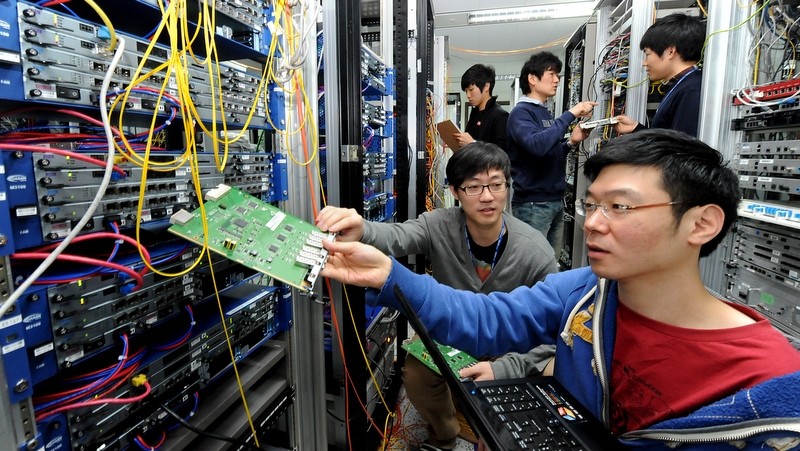The Vietnamese government reported that the economy’s labour productivity in general is on the rise. This would mean that the growth quality of the economy has gradually improved.
The increase in the country’s labour productivity is much higher than that in Southeast Asian economiesand many countries around the world. Notably, the climb was about 6% year-on-year last year, and 5.8% in the 2016-2018 period.
In 2011, the labour productivity of Singapore, Malaysia, Thailand, and Indonesia was 17.6, 6.3, 2.9, and 2.4 times, in turn higher than that of Vietnam. Nevertheless,the difference went down to 13.7, 5.3, 2.7, and 2.2 times, respectively, in 2018.
According to the International Labour Organisation, labour productivity is an important economic indicator that is closely linked to economic growth, competitiveness, and living standards within an economy. Labour productivity represents the total volume of output (measured in terms of GDP) produced per unit of labour (measured in terms of the number of employed persons) during a given time reference period.
At the recent conference on improving national labour productivity in Hanoi, Prime Minister Nguyen Xuan Phuc cited the International Monetary Fund (IMF) reporting that Vietnam’s total-factor productivity (TFP) has been ascending by an annual average 1.7% since 2013.
“With our strong economic reforms, the average TFP growth rate for the 2018-2023 period will be at least 1.8%, far higher than that in any other growth stage of the Vietnamese economy since the Doi moi was launched in 1986,” he stated.
TFP is a measure of the efficiency of all inputs to a production process. Increases in TFP usually result from technological innovations or improvements.
According to the Ministry of Planning and Investment (MPI), since the new government was elected in early 2016, the contribution of TFP to economic growth is maintaining its upwards trend.
Specifically, the TFP ratio in the economy sat at 33.58%in the 2011-2015 period, but climbed to 43.29% in the 2016-2018 period. Last year, the ratio sat at 43.5%.
Meanwhile, the economy’s labour productivity has also climbed 5.93% from US$4,166 per labourer in 2017 to US$4,512 in 2018. In 2016, the figure was US$3,852 per labourer.
Per capita GDP is estimated to be US$2,587 for 2018, up by US$198 against 2017.
In addition, the economy’s incremental capital output ratio (ICOR), which is the additional capital required to increase one unit of output, has reduced from 6.42 in 2016 to 6.11 in 2017, and 5.97% in 2018. The average ICOR for the 2016-2018 period is 6.17%, higher than the 6.25 of the 2011-2015 period.
Resolution 5 issued in November 2016 by the 12th Party Central Committee has made increasing labour productivity one of the three pillars for achieving a new growth model for the country, in addition to growth quality and increased competitiveness.
The resolution sets a target of raising productivity by 5.5% per year, and to have 30-35% of enterprises engage in innovative activities every year in the 2016-2020 period.
“We call for the business community, entrepreneurs, and investors to join hands with the Party and the government in making a breakthrough in labour productivity,” PM Phuc stressed.
The government expected that the economy will grow at about 6.8% this year. meanwhile, international organisations have different forecasts for Vietnam, such as the IMF (6.5%), the World Bank (6.6%), and the Asian Development Bank (ADB - 6.8%).
However, Vietnam is expected to continue with its highest growth rate in the region this year, such as China (6.3%), Indonesia (5.2%), and the Philippines (6.4%).
Improvement in growth quality
At a government meeting with ministries and localities organised in early this year, PM Phuc stated that though the growth rate is quite high, the economy’s credit growth has climbed from below 14%, lower than 17-18% seen in the previous years. This has reflected the economy has grown sharply in quality.
“Previously we were extremely anxious about a collapse in the national fiscal picture, but now we have a revenue excess worth US$3.5 billion from the initial estimate, with a record in foreign-exchange reserves,” he stated.
MPI Minister Nguyen Chi Dung stated that the private sector’s investment, which play a crucial role in economic growth, is also on the rise.
Specifically, this type of investment is estimated to occupy 42.4% of total economy investment in 2018, higher than the 40.6% last year and 38.9% in 2016, and the average of 38.3% in the 2011-2015 period.
“All sectors in the economy have been developing comprehensively in 2018, creating great momentum for higher growth,” the minister said. “Specifically, the agro-forestry-fishery sector have grown to a high level – 3.76%, the industrial and construction sector 8.85%, and the service sector 7.03%. The total revenue of retail and service consumption has also projected to climb 11.7% for 2018.”
Notably, according to the minister, the processing and manufacturing sector, which contributes to 80% of the economy’s industrial growth, continues its strong uptrend, at 11.9% in 2016, 14.5% in 2017, and 13% in 2018.
“All of these improvements which follow the government’s sound investment and business policies have also been seen with strongly growing confidence of businesses and investors,” Minister Dung said.
















